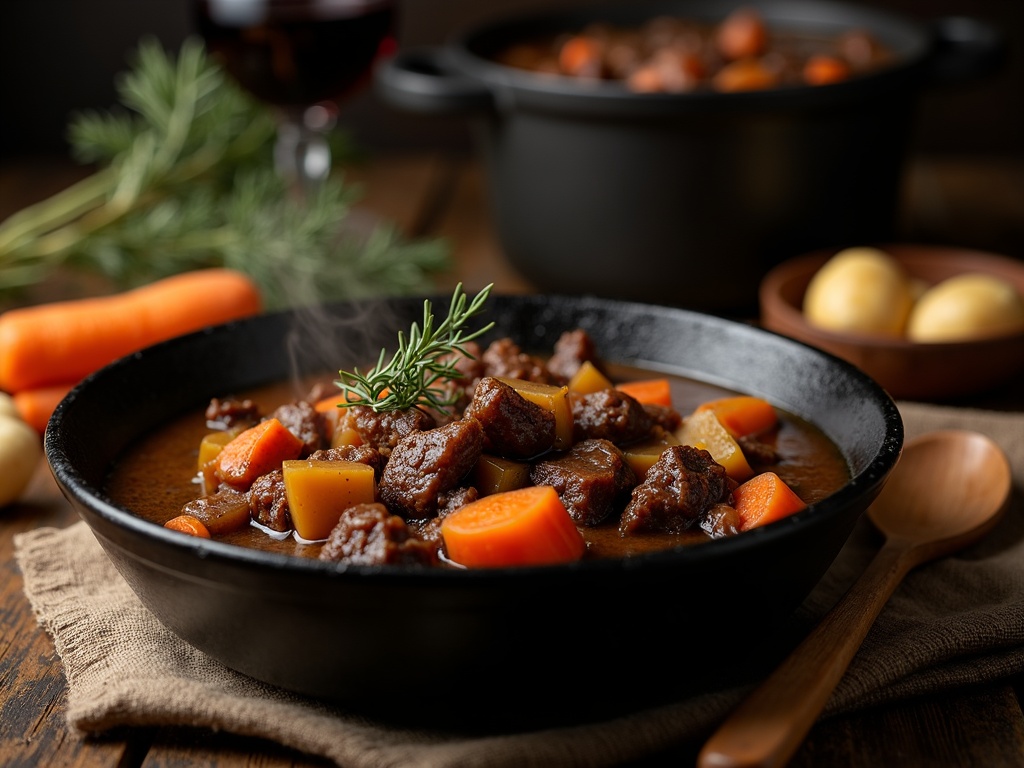Venison Recipes offers a rich, distinctive flavor that can transform ordinary meals into culinary adventures, especially when prepared with techniques that enhance its natural qualities rather than mask them. With proper preparation and cooking methods, this lean game meat becomes tender, flavorful, and versatile enough for everything from hearty stews to elegant grilled steaks.
Table of Contents
Key Takeaways
- Venison requires specific cooking techniques due to its leanness, with medium-rare (130-135°F) being ideal for most cuts to prevent dryness.
- Marinating venison helps tenderize the meat and infuse complementary flavors, with acidic ingredients like vinegar, or citrus juice being particularly effective.
- Proper browning and low, slow cooking methods transform tougher venison cuts into tender, flavor-packed meals, especially for stews and roasts.
- Complementary seasonings such as rosemary, thyme, juniper berries, and garlic enhance venison’s natural flavor without overwhelming it.
- Venison is a nutritional powerhouse with high protein content, low fat, and abundant vitamins and minerals, making it healthier than many conventional meats.
Classic Venison Stew Recipe
When the weather turns cold, nothing satisfies like a hearty venison stew. This classic recipe transforms tough venison cuts into tender, flavor-packed morsels swimming in rich gravy alongside earthy root vegetables. I’ve refined this recipe over years of game cooking to balance the unique flavor profile of venison with complementary ingredients.
Ingredients and Preparation
To create this rustic masterpiece, you’ll need:
- 2 pounds of venison stew meat, cut into 1-inch cubes
- 2 tablespoons vegetable oil
- 1 large onion, roughly chopped
- 3 garlic cloves, minced
- 2 carrots, peeled and cut into chunks
- 2 parsnips, peeled and cut into chunks
- 1 turnip, peeled and diced
- 3–4 potatoes, peeled and quartered
- 3 cups beef broth
- 2 tablespoons tomato paste
- 1 tablespoon Worcestershire sauce
- 1 bay leaf
- 3 sprigs fresh thyme
- 2 sprigs rosemary
- Salt and pepper to taste
The key to perfect venison stew lies in proper browning. I season the meat generously with salt and pepper, then sear it in batches in a hot Dutch oven until deeply browned on all sides. This creates a flavorful foundation and helps lock in moisture. Once the meat is browned, I set it aside and sauté the onions in the same pot to capture every bit of flavor left behind.
Cooking Method and Tips
The low, slow cooking process is what transforms this venison cube steak recipe into something special. After returning the meat to the pot, I add beef broth, tomato paste, Worcestershire sauce, and herbs. The liquid should just cover the meat.
Bring everything to a gentle simmer, cover, and let it cook for about 2 hours, checking occasionally. The magic happens during this time – tough venison fibers break down and the flavors meld together. After those 2 hours, I add the root vegetables and continue cooking for another hour until both meat and vegetables are fork-tender.
For the best flavor development, I recommend making this stew a day ahead. Like many slow-cooked dishes, the flavors intensify after resting overnight in the refrigerator. Simply reheat gently on the stovetop.
Venison can be leaner than traditional stew meats, so don’t skip the browning step. If you’re new to cooking wild game, this stew is an excellent gateway recipe. The long cooking process helps tame any strong flavors that might put off those unfamiliar with venison.
For a different wild game experience, you might also enjoy an elk roast recipe, which uses similar slow-cooking principles.
The final touch before serving should be a taste test for seasoning adjustments – venison often benefits from a final boost of salt and pepper. I serve this stew with crusty bread or over buttered egg noodles to soak up the rich gravy. A sprinkle of fresh parsley adds brightness to this deeply savory dish.
Remember that patience is your most important ingredient. The full 3-hour cooking time allows the venison to reach that perfect texture where it nearly falls apart with a gentle prod of your fork.
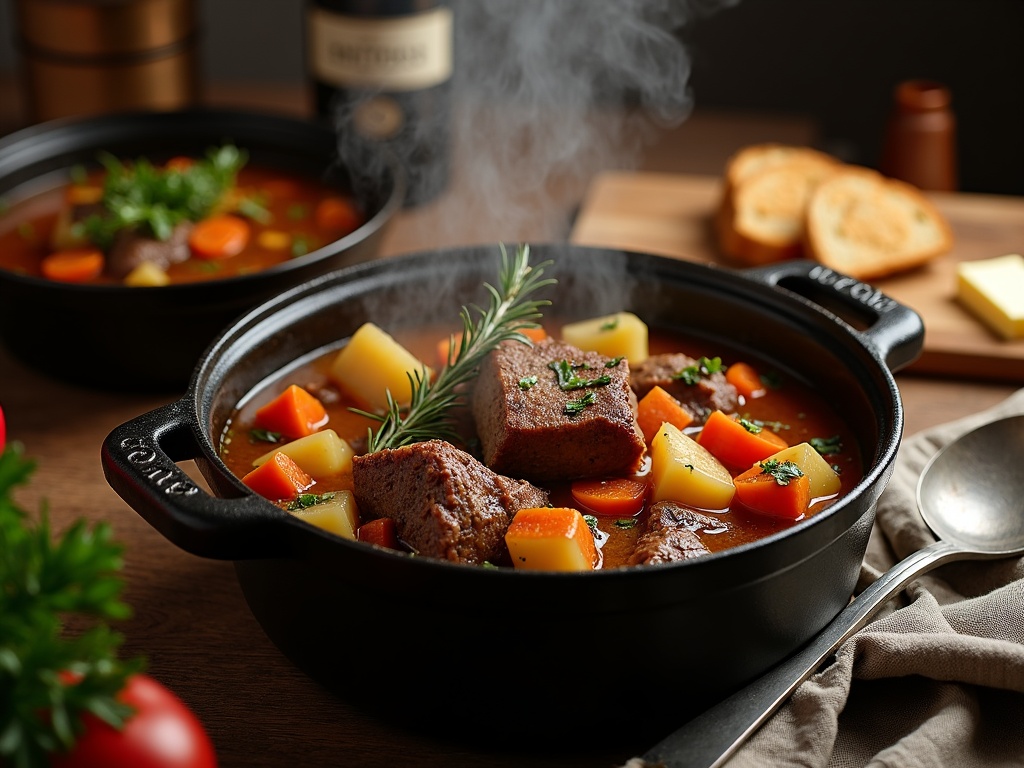
Step-by-Step Cooking Instructions
Cooking venison requires special attention to bring out its rich, distinctive flavor while keeping it tender. I’ve perfected these techniques through years of preparing wild game, and I’m excited to share them with you.
Preparing and Cooking Your Venison
The secret to outstanding venison dishes starts long before you turn on the heat. Marinating the meat overnight is crucial as it helps tenderize this lean game meat while infusing it with complementary flavors. I typically use a mixture of garlic, juniper berries, and herbs like rosemary and thyme. For tougher cuts, adding acidic ingredients like vinegar or citrus juice to your marinade helps break down the muscle fibers.
When you’re ready to cook, here’s the process I follow for consistently excellent results:
- Remove the venison from the marinade and pat it dry thoroughly with paper towels. This crucial step ensures proper searing.
- Heat a heavy-bottomed skillet or Dutch oven until it’s nearly smoking before adding high-heat oil like avocado or grapeseed.
- Sear the meat in batches, giving each piece plenty of space. Overcrowding lowers the pan temperature and results in steaming rather than searing. For steaks and medallions, aim for 2-3 minutes per side, depending on thickness.
- Set the seared meat aside on a warm plate and tent with foil to retain heat.
- Using the same pan with all its flavorful drippings, sauté your vegetables. Onions, carrots, and celery make a classic mirepoix base, but I often add mushrooms for their earthy flavors that complement venison perfectly.
- For slower-cooking dishes like stews or pot roasts, deglaze the pan with stock, or beer, scraping up all the browned bits to capture every ounce of flavor.
- Return the venison to the pan and combine with the vegetables. For stews and braises, add liquid until the meat is nearly covered.
- Bring everything to a simmer, then reduce heat and cover. For tough cuts, simmer gently for 2-3 hours until fork-tender. For tender cuts like backstrap or loin, cooking might take just 10-15 minutes.
The final step is often overlooked but makes all the difference. Let your venison rest before serving – at least 10 minutes for steaks and up to 30 minutes for larger roasts. This allows the juices to redistribute throughout the meat instead of running out when you slice it.
This method works beautifully for classic preparations like
tender deer cube steaks with mushroom sauce or a hearty
elk roast with root vegetables.
For those new to cooking venison, keep in mind that it’s much leaner than beef. This makes it healthier but also means it can dry out quickly if overcooked. Using a meat thermometer is helpful – aim for 130-135°F for medium-rare, which most chefs consider optimal for venison.
If you’re cooking ground venison for burgers or meatballs, consider mixing in some Halal bacon to add moisture and richness. A ratio of about 80% venison to 20% fat creates the perfect balance.
When preparing venison sausages or jerky, the addition of fat is even more important. These preparations often benefit from a day or two of curing with appropriate seasonings before the final cooking process.
Finally, don’t forget that different cuts require different cooking methods:
- Tender cuts like backstrap (loin) are perfect for quick-cooking methods like grilling or pan-searing.
- Tougher cuts like shoulders or shanks benefit from slow cooking methods that break down the connective tissues.
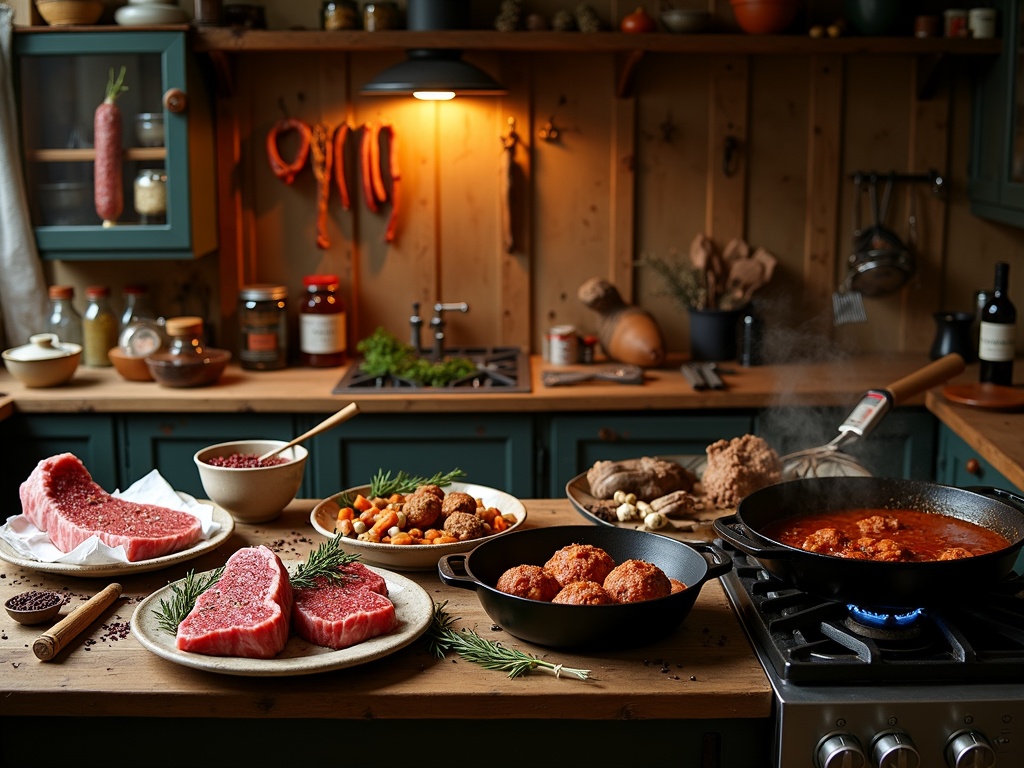
Grilled Venison Steaks
Cooking venison steaks on the grill requires attention to detail and proper technique to bring out the rich, gamey flavor while keeping the meat tender and juicy. I’ve found that backstrap or tenderloin cuts are perfect for grilling because of their natural tenderness and minimal connective tissue.
Selecting and Preparing the Cuts
Backstrap, often called the “deer fillet,” sits along the spine of the deer and offers some of the most prized meat. Tenderloin, slightly more delicate, comes from beneath the spine in the lower back area. When preparing these cuts, I remove any silver skin or membrane, which can cause the meat to curl during cooking and adds unwanted toughness.
For best results, I slice these prime cuts into 1 to 1½-inch steaks. This thickness allows for beautiful searing on the outside while maintaining a juicy, medium-rare center. Venison is exceptionally lean, so cutting the steaks too thin often leads to overdone, dry meat.
Marinade Magic
Marinating venison serves two crucial purposes: adding flavor and tenderizing the meat. My go-to marinade combines:
- ½ cup olive oil (provides moisture and helps carry flavors)
- ¼ cup balsamic vinegar (tenderizes and adds sweetness)
- 3 tablespoons Worcestershire sauce (enhances the meat’s natural flavor)
- 4 minced garlic cloves (adds aromatic depth)
- 1 tablespoon fresh rosemary (complements the gamey notes)
- 1 tablespoon black pepper
- 1 teaspoon sea salt
I place the steaks and marinade in a ziplock bag, removing as much air as possible, then refrigerate for 4-12 hours. Any longer than 12 hours and the acid in the marinade can start to break down the meat too much, giving it a mushy texture.
For those looking to explore more complex flavors, I’ve created several delicious deer cube steak recipes that use different marinades and cooking techniques.
Mastering the Grill
Temperature control makes or breaks venison on the grill. I preheat my grill to high heat (450-500°F) to get a good initial sear, then reduce to medium-high (375-400°F) to finish cooking without burning. This two-zone setup gives me flexibility to manage flare-ups and control doneness.
For a perfectly grilled venison steak:
- Remove steaks from marinade and pat dry with paper towels
- Let stand at room temperature for 20 minutes before grilling
- Place on the hot zone for 2-3 minutes per side to sear
- Move to medium-high zone and continue grilling until desired doneness
- For medium-rare (recommended), aim for an internal temperature of 130-135°F
Medium-rare is ideal for venison since its low fat content means it can dry out quickly if cooked past 140°F. I always use a meat thermometer rather than guessing, as the timing can vary based on thickness and exact grill temperature.
The Critical Resting Period
Resting venison after grilling is non-negotiable. I transfer the steaks to a cutting board, tent them loosely with foil, and let them rest for 5-10 minutes. During this resting period, the internal temperature will rise another 5°F in a process called carryover cooking, and the juices redistribute throughout the meat instead of spilling out when cut.
This technique works beautifully for other game meats as well. Many of the same principles apply when preparing an elk roast recipe, though cooking times will differ for larger cuts.
The resting period transforms a good venison steak into an exceptional one. When sliced against the grain after proper resting, the meat will be incredibly tender with a beautiful pink center and flavorful crust from the grill marks.
Common Mistakes to Avoid
Venison is a delightful meat that offers rich flavors and health benefits, but it requires specific cooking techniques to truly shine. When working with venison, I’ve learned that avoiding certain pitfalls makes all the difference between a remarkable meal and a disappointing one. Let me share the most common mistakes I’ve encountered and how to prevent them.
Preserving Venison’s Natural Quality
Overcooking is perhaps the biggest mistake when preparing venison. This lean meat lacks the fat content of beef, making it much more susceptible to drying out. I always cook venison to medium-rare or medium at most, which typically means an internal temperature of 130-135°F for steaks and chops. Once the temperature exceeds 140°F, you’ll notice the meat becomes tough and loses its natural juiciness. For roasts, I aim for 135-140°F, then let the temperature rise during resting.
Skipping the marinating step is another oversight that can affect your results dramatically. Venison benefits enormously from marinating, which helps tenderize the meat and infuse it with complementary flavors. An acidic marinade with ingredients like vinegar, or citrus juice breaks down some of the muscle fibers, resulting in more tender meat. I recommend marinating for at least 4 hours, though overnight delivers the best results. For a quick meal, even a 2-hour marinade can make a noticeable difference in venison cube steak preparations.
Using high heat can quickly ruin your venison dish. The low fat content means the meat doesn’t have natural protection against intense heat. I cook venison using lower temperatures than I would for beef—medium heat works well for most cuts. For steaks, I sear briefly on each side, then finish at a lower temperature. For an elk roast or venison roast recipe, slow cooking at 275-325°F gives superior results compared to traditional roasting temperatures.
Not letting the meat rest after cooking is a mistake even experienced cooks sometimes make. Resting allows the juices to redistribute throughout the meat instead of flowing out when you cut into it. I always let steaks rest for 5-10 minutes, while larger roasts benefit from 15-20 minutes of resting time. This simple step preserves moisture and improves texture significantly.
Beyond these major mistakes, I’ve found that several other factors can impact your venison cooking success:
- Failing to trim silver skin and sinew properly
- Not adjusting cooking times for wild vs. farm-raised venison
- Using inappropriate seasoning that overpowers the natural flavor
- Cooking frozen or partially thawed meat
- Neglecting to bring meat to room temperature before cooking
Even small adjustments can transform your venison dishes. I’ve discovered that handling venison with care from field to table makes a remarkable difference in the final product. Wild game cooking requires attention to detail, but the rewards are worth mastering these techniques.
By avoiding these common mistakes, you’ll bring out the best in this special meat. Venison offers a unique flavor profile that, when treated correctly, delivers exceptional meals that showcase why this protein has been prized for centuries.
Tips for Tender Venison
Cooking venison successfully requires understanding its unique properties. While this lean game meat offers exceptional flavor, it can become tough if handled improperly. I’ve discovered several foolproof techniques through years of preparing wild game that will help you achieve tender, delicious venison dishes.
Mastering Venison Preparation
Selecting the right cut dramatically impacts your final dish. The backstrap and tenderloin are naturally tender and perfect for quick-cooking methods like grilling or pan-searing. For tougher cuts like shoulder or neck, I recommend slow-cooking methods such as braising or using a pressure cooker, which break down connective tissue. You might consider trying venison cube steak recipes that tenderize naturally tougher cuts through mechanical means.
Marinades with acidic components work wonders for venison. I typically use a mixture of:
- Vinegar, or citrus juice (for acidity that breaks down muscle fibers)
- Olive oil (which helps maintain moisture during cooking)
- Garlic, herbs, and spices (for flavor enhancement)
- A touch of salt (which helps proteins retain moisture)
For best results, marinate tender cuts for 2–4 hours and tougher cuts for up to 24 hours in the refrigerator.
Temperature control is critical when cooking venison. Medium-rare (130–135°F) is ideal for most cuts, as venison dries out quickly when overcooked due to its low fat content. I always use a meat thermometer to ensure precision and rest the meat for 5–10 minutes before slicing to allow juices to redistribute.
When serving, cut against the grain (perpendicular to the muscle fibers) to shorten the tough fibers and create a more tender bite. This technique is particularly important when preparing larger cuts like an elk roast recipe or venison steaks.
For exceptionally tough cuts, consider mechanical tenderizing methods such as:
- Pounding with a meat mallet
- Using a jaccard tool to break down muscle fibers
Remember that venison cooks 20–30% faster than beef due to its leanness, so adjust cooking times accordingly to avoid transforming your prized game meat into an unappetizing, leathery disappointment.
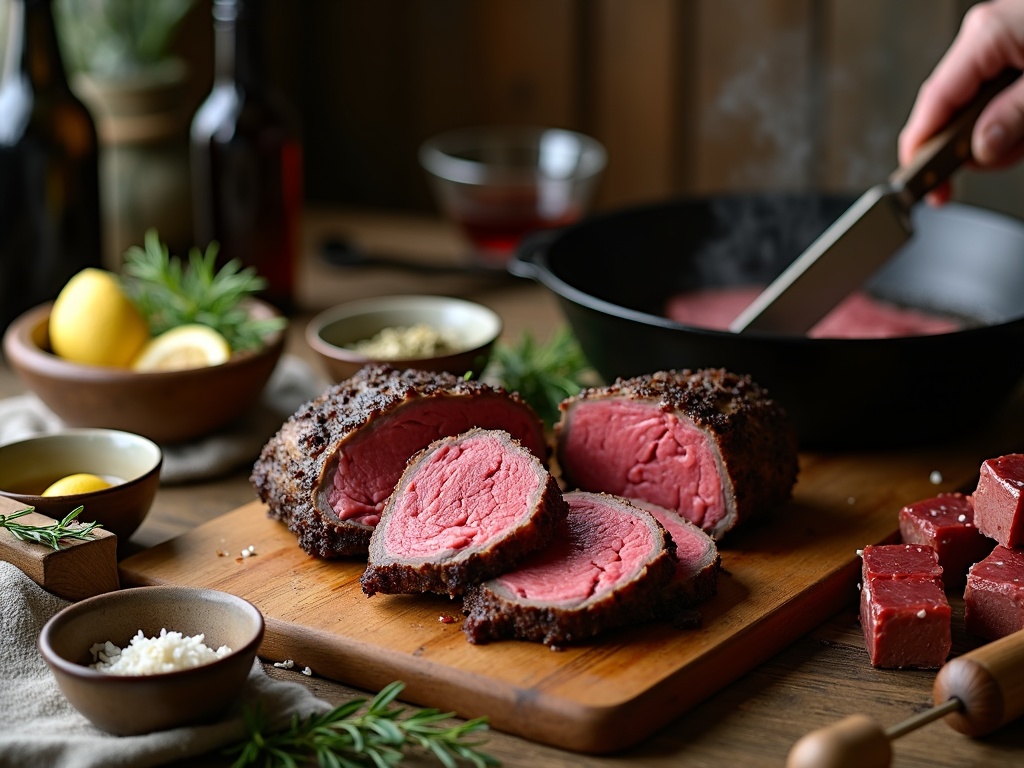
Storage and Preparation
Handling venison correctly before cooking is critical for maximizing flavor and ensuring food safety. I’ve learned through years of experience that proper storage starts the moment the deer is harvested and continues until the meat hits your plate.
Storing Your Venison Properly
Freezing venison correctly extends its shelf life while preserving quality. I always double-wrap my cuts first in plastic wrap, then in freezer paper or vacuum-seal them to prevent freezer burn. Label each package with the cut name and date — this practice has saved me countless times when planning meals.
For optimal quality, here are the recommended freezer storage times for venison:
- Ground venison: 3-4 months
- Steaks and roasts: 6-9 months
- Stew meat and cubes: 4-6 months
The temperature of your freezer matters significantly. Set it to 0°F (-18°C) or below for long-term storage. I’ve found that a dedicated game freezer, if you have space, helps maintain consistent temperatures better than frequently-opened kitchen freezers.
When it comes to thawing, patience is key. I recommend these safe methods:
- Refrigerator thawing: Place frozen venison on a plate or tray (to catch any drips) in your refrigerator for 24-48 hours, depending on thickness.
- Cold water thawing: Submerge sealed packages in cold water, changing water every 30 minutes until thawed.
- Never thaw venison at room temperature as this promotes bacterial growth.
For those looking to try different cuts, deer cube steak recipes offer incredible versatility once you’ve mastered proper thawing techniques.
Trimming is perhaps the most crucial preparation step with venison. Unlike beef, venison fat doesn’t add flavor — it creates gaminess. I always trim away all visible fat, silver skin (the shiny connective tissue), and any darkened meat edges. A sharp, flexible boning knife makes this task much easier.
For larger cuts like roasts, I use the seam method — following the natural muscle divisions to separate the meat into manageable portions. This approach not only makes preparation easier but also lets you freeze in meal-sized portions. If you’re planning a special dinner, elk roast recipes can be adapted for venison roasts with similar trimming techniques.
Safe handling practices can’t be overlooked when working with wild game. I follow these guidelines religiously:
- Keep raw venison separate from other foods
- Use dedicated cutting boards for game meat
- Wash hands thoroughly before and after handling
- Clean all surfaces and utensils with hot, soapy water
- Use a food thermometer to ensure proper cooking temperatures
Aging venison improves tenderness and flavor, but must be done carefully. If you have access to controlled refrigeration (33-40°F), whole cuts can be aged 7-14 days. For home refrigerators, I limit aging to 3-5 days maximum to ensure safety.
When preparing venison for cooking, I often soak tougher cuts or those with stronger flavors in a marinade containing acid (like buttermilk or vinegar) for 4-24 hours. This helps tenderize the meat and can reduce gaminess. Remember to pat the meat completely dry before cooking — especially before grilling or searing — to ensure proper browning.
Finally, don’t rush the process. Preparing venison takes time, but the results are worth every minute spent. Proper storage and preparation transforms this lean, sustainable protein into memorable meals that honor both the animal and your efforts in harvesting it.
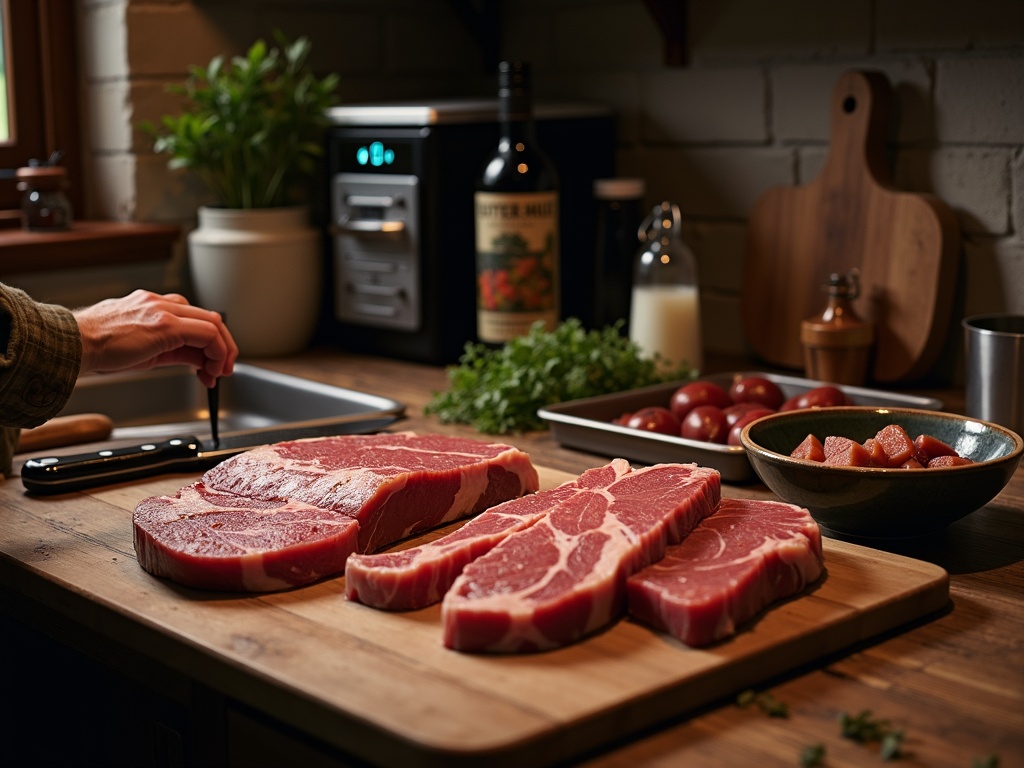
Seasoning Suggestions
Finding the right seasonings for venison can transform your wild game cooking experience. Venison’s rich, earthy flavor pairs beautifully with specific herbs, spices, and marinades that enhance rather than mask its natural taste. I’ve discovered some fantastic combinations that bring out the best in deer meat dishes.
Herbs and Spices That Elevate Venison
Fresh and dried herbs add complexity to venison dishes without overpowering the meat’s natural flavor. Rosemary stands out as my top choice for venison – its piney, aromatic quality naturally complements the game meat. Thyme, sage, and juniper berries also work exceptionally well, adding earthy notes that enhance the meat’s character.
When creating spice blends for venison, I recommend starting with these foundations:
- Classic Venison Rub: Combine black pepper, kosher salt, garlic powder, dried rosemary, and a touch of brown sugar for a balanced profile that works on steaks and deer cube steaks.
- Smoky Game Blend: Mix smoked paprika, ground coffee, black pepper, salt, and dried thyme for a deeper flavor perfect for grilling.
- Italian-Inspired Mix: Blend oregano, basil, garlic powder, crushed red pepper, and fennel seeds for Mediterranean-style dishes.
For the best results, apply dry rubs at least 30 minutes before cooking, though overnight in the refrigerator allows the flavors to penetrate deeper.
Marinades That Deepen Flavor and Tenderize
Marinades serve a dual purpose with venison – they add flavor while helping to tenderize what can sometimes be a lean, firm meat. My go-to marinades include:
- Buttermilk Soak: Mix buttermilk with salt, pepper, and a bay leaf to help remove any gamey flavors and tenderize the meat. This works particularly well for steaks or medallions.
- Whiskey-Maple Marinade: Blend bourbon or whiskey with maple syrup, soy sauce, garlic, and black pepper for a sweet-savory combination that pairs nicely with elk roast recipes but works beautifully with venison too.
For optimal results, I marinate smaller cuts for 4–8 hours and larger roasts for up to 24 hours in the refrigerator.
Tailor Seasonings to the Cut
I’ve found that the right seasoning approach depends on the specific cut of venison. Tender backstrap (loin) benefits from minimal seasoning, while tougher cuts like shoulder or shank require more aggressive flavoring techniques including longer marinades or slow cooking with aromatics.
Remember that venison’s natural flavor deserves respect – the goal isn’t to mask it but to enhance what makes this game meat special. By choosing complementary herbs, creating balanced spice blends, using effective marinades, you’ll highlight venison’s unique character while creating memorable meals.
Serving Ideas
Venison’s rich game flavor pairs beautifully with the right accompaniments, transforming your wild game dinner into a memorable culinary experience. I’ve found that thoughtful presentation and complementary sides can elevate even simple venison steak recipes to restaurant-quality meals.
Perfect Pairings and Presentation
The robust flavor profile of venison calls for sides that can stand up to its distinctive taste without overwhelming it. I’ve discovered these side dishes work exceptionally well:
- Root vegetables: Roasted parsnips, carrots, and turnips caramelize beautifully and complement Venison’s earthy notes
- Mushroom preparations: Wild mushroom risotto or sautéed mushrooms with garlic and herbs echo the woodland origins of the meat
- Fruit-forward sides: Cranberry relish, apple compote, or pear slices provide welcome acidity to cut through the richness
- Starches: Creamy polenta, garlic mashed potatoes, or wild rice pilaf offer hearty foundations that absorb meat juices
- Green vegetables: Brussels sprouts, braised kale, or roasted asparagus add color and fresh contrast
When plating your elk roast or venison, I recommend following a few key principles. First, allow the meat to rest properly before slicing to keep juices intact. For elegant presentation, slice Deer meat against the grain into medallions of even thickness. Consider the “clock method” with the protein at 6 o’clock, starch at 10 o’clock, and vegetables at 2 o’clock for balanced visual appeal.
Height adds drama to plating—try stacking sliced venison over a small mound of mashed potatoes or polenta. Always leave some negative space on the plate rather than crowding components together, which allows each element to shine.
I find that applying sauce judiciously—either pooled underneath meat, drizzled across, or served in a small side vessel—prevents drowning the venison’s natural flavor.
For finishing touches, consider these garnishes that add both flavor and visual appeal:
- Fresh herbs like rosemary sprigs, thyme leaves, or chopped chives
- Edible flowers for special occasions
- Microgreens or pea shoots for color and texture
- Crispy fried shallots or garlic chips for textural contrast
- Coarse sea salt flakes or freshly cracked pepper
- Citrus zest for brightness
I’ve learned that temperature contrast matters too—serving hot Deer meat with a cool element like a small dollop of herbed crème fraîche creates an interesting sensory experience.
When serving venison to guests unfamiliar with game meat, I start with smaller portions accompanied by familiar sides. This approach helps introduce the distinctive flavor profile without overwhelming newcomers.
Remember that venison cooks more quickly than beef and continues cooking after being removed from heat. Serving promptly on warmed plates helps maintain the ideal temperature and prevents the lean meat from becoming tough.
Health Benefits of Venison Recipes
Venison stands out as one of the most nutritious game meats available, delivering exceptional health benefits while maintaining delicious flavor. I’ve found that understanding its nutritional makeup helps home cooks appreciate why it’s worth adding to your regular meal rotation.
Nutritional Powerhouse
Venison offers an impressive nutritional profile that makes it a smart choice for health-conscious eaters. A 3-ounce serving contains approximately 26 grams of protein, making it one of the leanest, protein-rich meats available. This high protein content supports muscle growth and repair, while also keeping you feeling fuller longer.
The fat content in Deer meat deserves special attention. Unlike domesticated meats, venison contains only about 2 grams of fat per 3-ounce serving, with minimal saturated fat. This makes it particularly valuable for those monitoring their fat intake or following heart-healthy diets.
Deer meat is also packed with essential vitamins and minerals your body needs:
- Iron: Contains nearly twice the iron of beef, helping prevent anemia and supporting oxygen transport
- B vitamins: Rich in B12, B6, and niacin, supporting energy metabolism and nervous system function
- Zinc: Provides immune system support and aids in wound healing
- Phosphorus: Essential for bone health and cellular repair
- Selenium: Acts as an antioxidant protecting cells from damage
When compared to other common meats, venison consistently comes out on top nutritionally. It has less fat than chicken breast, more protein than beef, and fewer calories than both. A 3-ounce serving of venison contains about 130 calories, compared to 215 calories in the same portion of beef.
For those interested in expanding their venison cooking repertoire, delicious deer cube steak recipes offer excellent ways to enjoy these health benefits in satisfying meals. The lean nature of Deer meat also makes it perfect for slow-cooking methods, as demonstrated in many elk roast recipe variations that allow the meat to remain tender while absorbing complementary flavors.
What makes venison particularly valuable from a health perspective is that it’s free-range by nature. Deer forage on natural vegetation, resulting in meat free from antibiotics and growth hormones commonly found in factory-farmed animals. This natural diet contributes to venison’s higher levels of omega-3 fatty acids compared to conventional meats, potentially offering anti-inflammatory benefits.
The combination of high-quality protein, essential nutrients, and minimal fat makes venison an excellent choice for anyone looking to maintain a healthy diet without sacrificing flavor or satisfaction.
Sources:

